Norrköping
| Norrköping | |||
|---|---|---|---|
|
|||
| Nickname(s): Peking, Little Manchester | |||
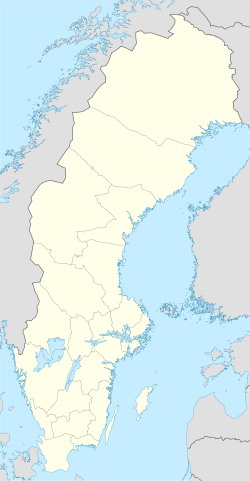 Norrköping
|
|||
| Coordinates: | |||
| Country | Sweden | ||
| Province | Östergötland | ||
| County | Östergötland County | ||
| Municipality | Norrköping Municipality | ||
| Area[1] | |||
| - Total | 34.78 km2 (13.4 sq mi) | ||
| Population (2005-12-31)[1] | |||
| - Total | 83,561 | ||
| - Density | 2,403/km2 (6,223.7/sq mi) | ||
| Time zone | CET (UTC+1) | ||
| - Summer (DST) | CEST (UTC+2) | ||
| Website | norrkoping.se | ||
Norrköping [ˈnɔrɕøːpɪŋ] is a city in the province of Östergötland in eastern Sweden and the seat of Norrköping Municipality, Östergötland County. The city has a population of 83,561 inhabitants in 2005,[1] out of a municipal total of 127,059[2], making it Sweden's tenth largest city and eighth largest municipality.
The city is situated by the mouth of the river Motala ström, at Bråviken, an inlet of the Baltic Sea. Water power from the Motala ström and the good harbour were factors that facilitated the rapid growth of this once industrial city, known for its textile industry. It has several nicknames such as: "Sweden's Manchester" , "Peking" and "Surbullestan" (Surbulle was a local nickname for the textileworkers, and stan´ is short for Staden, which means The City or The Town in Swedish)
Contents |
History

The city has medieval foundations by settlers around the Norrköping twin city with Linköping Motala stream estuary, who used the falls and rapids to power their mills. The stream was also full of fish such as salmon. Exact dates are uncertain, but there are mentions of a church in the 12th century. It was dedicated to Saint Olaf, Norway's patron.
The first trace of the city's name is from 1283, when wealthy David Appelgren - [Lord of Östergötland] - donated his rights of salmon fishing to the Skänninge monastery. The town is estimated to have received city status in the early 14th century, although no written documents exist prior to a document from 1384. This document, signed by Albrekt of Sweden is stored in the city archive today.
The city was the location of several battles in the ensuing centuries. As a consequence, nothing of the medieval Norrköping remains today. During the Northern Seven Years' War (1563–1570), the entire southern part of Norrköping was burnt. It was rebuilt by John III of Sweden ,who designed the current street pattern.
In 1618, a weapon industry was established by supervision of Gustavus Adolphus. The harbour also attracted ships due to its proximity to the industries of Finspång. In addition to the weapon industry, a large scale industry of textile was also initiated. An important benefactor was the industrial man Louis De Geer (1587-1652). At De Geer's death, Norrköpings had 6,000 inhabitants and was Sweden's second largest city.
The city again burnt in 1655, and again in 1719 during the Great Northern War when the Russians burnt it to the ground. Stones from the Johannisborg castle were used to build new houses, and today only a few stones remain.
During the 18th century it was rebuilt and several industries soon got a stronghold: In the 1740s, Norrköping boosted three sugar refineries; in the 1750s the large scale influential snuff industry was established. From this time stems the city churches of Saint Olof and Saint Hedvig, and several other old houses.
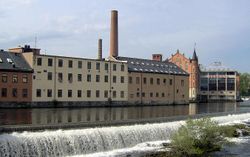
Norrköping's importance again flourished. In 1769 the Swedish Riksdag assembled there. In 1800 the king Gustav IV of Sweden was crowned in the Church of Saint Olof.
The city again suffered fires in 1822 and 1826. Thereafter wooden houses were banned. In 1841 a ship industry was initiated as a branch of Motala Verkstad in Motala. In 1850 the industry had over 600 employees making it Sweden's largest ship industry at the time. During the remaining 19th century, the industries kept expanding. The area by the Motala Stream was developed further with the construction of a cotton refinery, and a paper mill was constructed in 1854, specializing in newspaper, and is still today exporting to customers around the world.
The industry, including textile manufacturers, also expanded into the 20th century. In 1950 a total of 54 factories had 6,600 employees in town. By 1956, however, 18 of them had been closed due to competition from countries abroad with lower wages, such as Italy and Japan. In 1970 only 10 factories and 1,200 employees remained. In that year, the renowned Holmen paper mill, with its 350 years long history, announced closure, and another 900 people were let go. To counter the effects, several governmental authorities were relocated to Norrköping from Stockholm. See also Braviken Paper Mill.
As of 2002, Norrköping is now seeing a revival, as a center of culture and education. The Norrköping symbol represents the "new" Norrköping.
Main sights
The Strömmen river flows through the city has a parade annexed. In connection to the latter is the industrial landscape where the old textile industries once where situated.[3]
In the summer, there is a cactus plantation in Carl Johans Park. 25,000 cactuses are planted there every summer.[4]
Kolmårdens Djurpark is a zoo located 30 km north of Norrköping. In connection to the large outdoor zoo, there is also Tropicariet, an aquarium, where for example snakes, crocodiles and sharks can be seen.[5]
The archipelagos 50 km away from Norrköping are called St Anna and Gryt.[6]
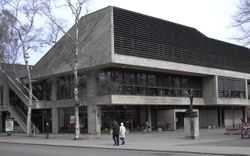
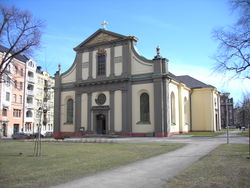
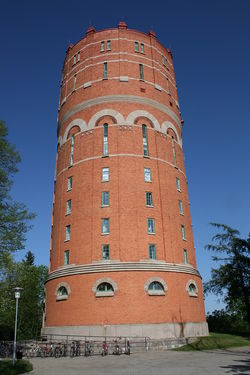
A campus of Linköping University, its own symphonic orchestra, an airport called Kungsängen with 170,000 traveling (2006), a high-tech industry park called Norrköping Science Park,[7] and Petroglyphs from the Nordic Bronze Age.
Notable natives
- Hannes Alfvén - physicist, Nobel Prize winner
- Moa Martinson - author
- Laakso - music group
- Michael B. Tretow - producer and audio engineer
- Ture Nerman - poet and socialist politician
- Peter Harryson - actor, entertainer
- Pernilla Wiberg - alpine skier, double Olympic gold medalist
- Slagsmålsklubben - electronic popgroup
- Malin Baryard - horse rider
- Eldkvarn - music group
- Marduk - music group
- Amy Diamond - singer
- 23 Till - music group
- Elin Grindemyr - model
Sports
- IFK Norrköping (Association football)
- Norrköping Dolphins (Basketball)
- HC Vita Hästen (Icehockey)
- Vargarna (Speedway)
- Norrköpings KK (Swimming)
References
- ↑ 1.0 1.1 1.2 "Tätorternas landareal, folkmängd och invånare per km2 2000 och 2005" (in Swedish) (xls). Statistics Sweden. http://www.scb.se/statistik/MI/MI0810/2005A01B/T%c3%a4torternami0810tab1.xls. Retrieved 2009-05-09.
- ↑ Folkmängd i Norrköpings kommun den 31 maj 2008
- ↑ http://www.upplev.norrkoping.se/attgora.asp/id/6040/lid/70499
- ↑ http://www.upplev.norrkoping.se/attgora.asp/id/604025/lid/69094
- ↑ http://www.kolmarden.com/
- ↑ http://www.upplev.norrkoping.se/Sk%E4rg%E5rd%5F2__1033.html
- ↑ For Sweden's planners, visualization's the real deal - EE Times, 12/03/2007. Accessed 2009-08-09
External links
| Norrköping is one of 133 places with the historical city status in Sweden. |
|
|||||
|
||||||||||||||
|
|||||||||||||||||||||||||||||||||||||||||||||||||
|
|||||||||||||||||||||||||||||||||||||||||||||||||||||||||||||||||||||||||
